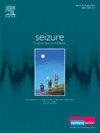Modified atkins diet versus topiramate in young children with epileptic spasms refractory to steroids and vigabatrin: a randomised open-label trial
IF 2.8
3区 医学
Q2 CLINICAL NEUROLOGY
引用次数: 0
Abstract
Background
There is a paucity of evidence regarding the best treatment options for children with infantile epileptic spasm syndrome who have failed the first-line treatments, i.e. hormonal therapy and/or vigabatrin. The study aimed to compare the efficacy and tolerability of the Modified Atkins Diet (MAD) versus Topiramate in this population.
Methods
This was a randomized open-label trial that enrolled children with infantile epileptic spasm syndrome who had failed a trial of hormonal therapy and vigabatrin. Patients were randomly assigned to receive either MAD or Topiramate. Both groups were assessed at 12 weeks for spasm frequency through parental records, improvement in electroencephalographic findings as measured by the BASED (Burden of AmplitudeS and Epileptiform Discharges) score, adverse effects, and improvement in non-seizure domains. Intention-to-treat analysis was performed.
Results
A total of 80 children were recruited, with 40 children each in the MAD and topiramate arms. Children in the MAD arm showed a statistically significant improvement compared to the Topiramate arm at 12 weeks in terms of >50% spasm reduction (27/40, 67.5% vs. 17/40, 42.5%, p- 0.02), >90% spasm reduction (9/40, 22.5% vs. 2/40, 4.76%, p- 0.02), > 1 point improvement in BASED score (16/40, 40% vs. 5/40, 12.5%, p- 0.005), and improvement in alertness (7/40, 17.5% vs. 1/40, 2,5%, p=0.026). Both interventions were well tolerated by the children, with mild side effects, including constipation, diarrhoea, and anorexia in the MAD arm, and anorexia and somnolence in the topiramate arm.
Conclusion
MAD proved to be more effective than Topiramate in managing epileptic spasms refractory to first-line treatment. However, further studies with larger sample sizes and longer follow-up periods are required to generalize the findings. (ClinicalTrials.gov, NCT05958160).
改良阿特金斯饮食与托吡酯对顽抗类固醇和维加巴林癫痫痉挛的幼儿:一项随机开放标签试验
背景:对于一线治疗(即激素治疗和/或维加巴林治疗)失败的婴儿癫痫痉挛综合征患儿,目前缺乏关于最佳治疗方案的证据。该研究旨在比较改良阿特金斯饮食法(MAD)与托吡酯在该人群中的疗效和耐受性。方法:这是一项随机的开放标签试验,招募了患有婴儿癫痫痉挛综合征的儿童,这些儿童在激素治疗和维加巴林的试验中失败。患者被随机分配接受MAD或托吡酯治疗。两组在12周时通过父母记录评估痉挛频率,通过基于(振幅和癫痫样放电负担)评分测量的脑电图结果的改善,不良反应和非癫痫发作领域的改善。进行意向治疗分析。结果共纳入80例儿童,MAD组和托吡酯组各40例。与托吡酯组相比,MAD组儿童在12周时痉挛减少50% (27/40,67.5% vs. 17/40, 42.5%, p- 0.02),痉挛减少90% (9/40,22.5% vs. 2/40, 4.76%, p- 0.02), basis评分改善1分(16/40,40% vs. 5/40, 12.5%, p- 0.005),警觉性改善(7/40,17.5% vs. 1/40, 2.5%, p=0.026),在统计学上有显著改善。两种干预措施均被儿童耐受良好,副作用轻微,包括MAD组的便秘、腹泻和厌食症,托吡酯组的厌食症和嗜睡。结论在治疗难治性癫痫性痉挛的一线治疗中,mad比托吡酯更有效。然而,进一步的研究需要更大的样本量和更长的随访期来推广这些发现。(ClinicalTrials.gov NCT05958160)。
本文章由计算机程序翻译,如有差异,请以英文原文为准。
求助全文
约1分钟内获得全文
求助全文
来源期刊

Seizure-European Journal of Epilepsy
医学-临床神经学
CiteScore
5.60
自引率
6.70%
发文量
231
审稿时长
34 days
期刊介绍:
Seizure - European Journal of Epilepsy is an international journal owned by Epilepsy Action (the largest member led epilepsy organisation in the UK). It provides a forum for papers on all topics related to epilepsy and seizure disorders.
 求助内容:
求助内容: 应助结果提醒方式:
应助结果提醒方式:


